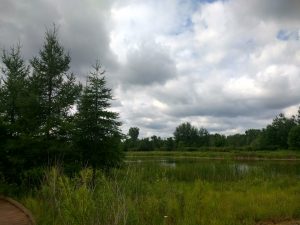Water, the Root of the Solution: Exploring water’s role in the health of the environment
Written by: Jessica Getschman, C.I.G. – Indian Springs Metropark Interpreter
Michigan is known for its fresh water, and that includes more than just the Great Lakes. Swamps, fens, marshes, rivers, and so many more types of wetlands are found scattered throughout our state. This makes water quality a great place to start the conversation about a healthy environment in Michigan. An important thing to remember when thinking about a healthy environment, is that we’re really talking about supporting healthy ecosystems. Water happens to be one of the key components in ecosystems.
There are two parts to defining what an ecosystem is. The main idea is that ecosystems are a group of living organisms and the linked non-living parts of the place they live in. Invariably, one of those parts will always be water because water is one of the five things essential to all life—the others being food, shelter, air, and space. It’s important to realize that water isn’t just “water”. Water in nature also includes the nutrients, pH, microbes, contaminants, and so much more. Even the temperature will impact properties of the water and what life is viable.
This ties into the second half of the definition of an ecosystem, inhabitants within ecosystems are tied by  cycles of nutrients and energy in the place they live. To help understand this concept, think about a drop of rain. There are many places the rain may fall, and once there it will move to new parts of the system. For example, it may fall to the soil where it will be taken in by the roots of a plant. That plant may then be eaten by an animal where it eventually ends up as well, a liquid once more. The water and soil (non-living things) are connected to the plants and animals (living things) in this equation. The quality of the water then is important, but how do we know if the water quality is on track?
cycles of nutrients and energy in the place they live. To help understand this concept, think about a drop of rain. There are many places the rain may fall, and once there it will move to new parts of the system. For example, it may fall to the soil where it will be taken in by the roots of a plant. That plant may then be eaten by an animal where it eventually ends up as well, a liquid once more. The water and soil (non-living things) are connected to the plants and animals (living things) in this equation. The quality of the water then is important, but how do we know if the water quality is on track?
To be able to tell if a waterway is healthy, we need a way to be able to test water. The direct approach is to send out trained people to do chemical checks on the water, but there are some nuances to this method. Instead, often we start with doing a biological assessment aimed at telling us if there are signs of a problem that we need to look deeper into. Most commonly this is done by looking for aquatic insects and other invertebrates; or as they’re referred to in the field, “benthic macroinvertebrates”. It’s a long name, but it basically just means these creatures live on the lowest level of a body of water, they can be seen without a microscope and they don’t have a backbone. Many familiar insects, such as mayflies and dragonflies, start out their lives in the water. If we notice a change in their numbers, we can get more detailed chemical tests to try to figure out where the problem is. They also serve as a mascot for protecting our waterways for a healthier environment.
Water has also been a cornerstone of much of our current environmental legislation. During the 1960’s and 1970’s it became more apparent that our waterways were deeply impacted by human actions. Rivers became a focal point as newspapers ran pictures of some waterways literally burning. As citizens called for action, the government was also looking for ways to protect our natural resources. The response came in the form of the Clean Air Act in 1970 and the Clean Water Act in 1972. Under these new law’s big contributors of air and water pollution had to track emissions to limit potential pollutants from reaching habitats. The plan was a success and the following decades saw drastic improvements to the state of our environment. Much of this legislation stands today continuing to protect both human and environmental health, thus showing again that water is at the root of the solution to environmental protection.
Your Metroparks focuses on water quality and has implemented a Stormwater Management Plan to reduce the discharge of pollutants into waterways. Approximately 94 miles of streambank, 65 miles of shoreline, 191 outfalls, and 600 culverts were assessed throughout the 13 Metroparks in creation of the plan. The full Stormwater Management Plan is available online for review.
Remember, water is all around us and plays a huge part in keeping the environment running smoothly. Whenever you are looking for ways to help protect natural resources, think back to water and how it truly is at the heart of our ecosystems!
